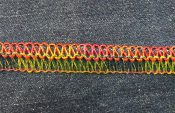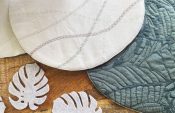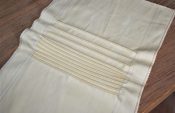I am very happy that, starting today, I will be able to report from my studio. I invite you to look over my shoulder when I sew my art quilts or design new embroideries. In the process, I will provide tips and tricks, and we will sew some small projects together.
I’ve been an avid Bernina user for eleven years now. I still own my first one, the Aurora 440, and today I have arrived at the Bernina 880, my Divina. There was a Dotty in-between (B750) and two B830s, Diva and Donna. You are right to assume that my hobby is my profession and my passion.
The latest addition to my studio is the Bernina 880, and I would like to invite you to explore with me this engineering marvel of sewing technology. No, I will not provide instructions for use – your dealer would probably be much better at this. What I would like to show you are all the things Divina and I have come up with.
I have been known to love decorative stitches in my work. They are an integral part of my quilts. It may not be a logical approach, but on the new B880 I had to try the new stitch designer first.
The things you can do with the stitch designer are absolutely amazing. You are able to design the whole range of pictorial motives up to completely abstract structures. It is a dream come true for me and my quilts!
Here, I have been moving within the 9mm range, but larger widths are possible.
The first sample I created was a small abstract work.
 I have recently started to take a peek into stone sculpting. Now I am making stone reliefs that I intend to use as media for rubbings on fabric. These rubbings will later be embroidered and quilted. The purple embroidery in my sample was designed with the stitch designer, and I was able to stitch through 3 layers without encountering any problems.
I have recently started to take a peek into stone sculpting. Now I am making stone reliefs that I intend to use as media for rubbings on fabric. These rubbings will later be embroidered and quilted. The purple embroidery in my sample was designed with the stitch designer, and I was able to stitch through 3 layers without encountering any problems.
This is how the stitch looks on a “test rag”.
Would you like to come along and explore the stitch designer and its potential with me? In future contributions to this blog I will introduce you to pictorial and abstract motives and show you how you can design them directly on the screen of the B880.
Oh, by the way, „test rag“ is one of my favorite words. Nothing goes without a „test rag”. All your designs should first be tried out on a test rag, on which you might write your notes as well. This will help you to follow up on your development. Also technical notes, like needle and thread used, might come in handy at a later time. This means you need solid fabrics with embroidery backing, best one that has been ironed on (size: about 15 x 20 cm or 6 x 8 inch).
Aren’t they cute? My little angels…We’ll be seeing each other, with the B880, the stitch designer, and your „test rags“!
Happy Easter!
Pia Welsch
By the way – this post was translated by Gabriele Schultz-Herzberger my dear friend. I will introduce her in one of my next posts.
 BERNINA Corporate Blog -
BERNINA Corporate Blog -










Thank you Hilary! And yes, stone sculpting is sooo exciting…
Oooo, what fun. Love the purple grass and reeds (that’s what I am seeing) are so effective. I totally agree with you about test rags – so important. Looking forward to stone sculpting… Hilary